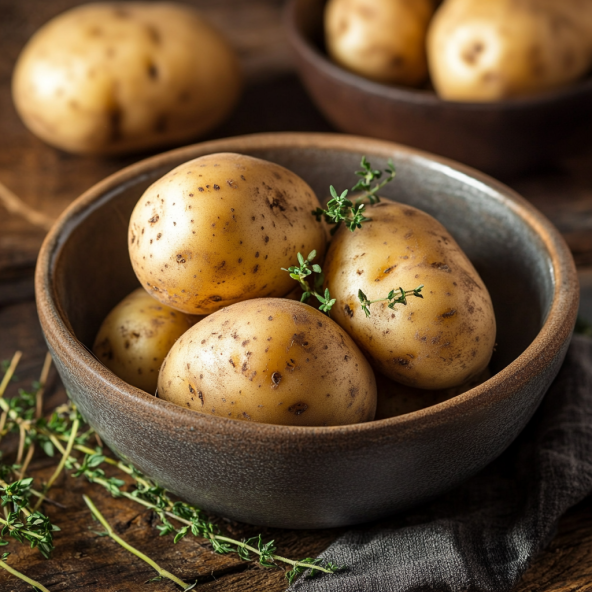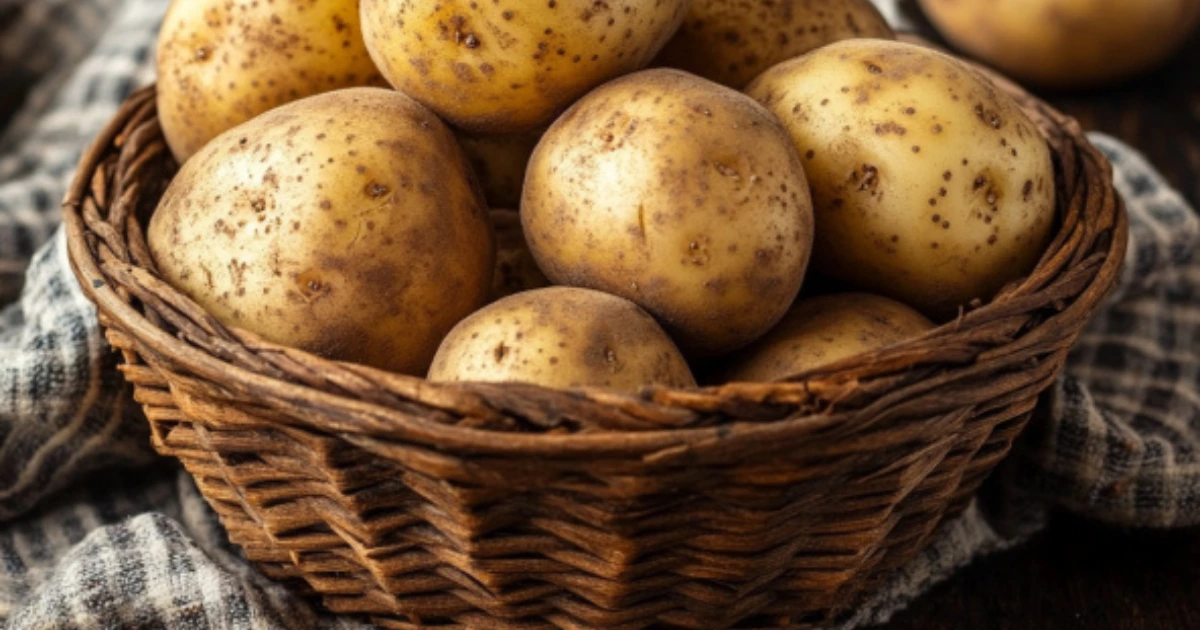What is Difference Between Normal Potato and Russet Potato?
What is the Difference Between Normal and Russet Potato ? When comparing a normal potato and a russet potato, several key differences set them apart. These differences include their appearance, nutritional profile, and ideal cooking uses. Understanding these distinctions can help you make more informed decisions in the kitchen. This article will explore the characteristics of both types of potatoes and when to use each for optimal results.
Table of Contents
Defining “Normal” Potato and Russet Potato
In the world of potatoes, the term “normal potato” generally refers to potatoes that aren’t categorized as specific varieties like russets. This could include potatoes such as Yukon Gold, red potatoes, or fingerlings. On the other hand, russet potatoes, specifically Russet Burbank, are a well-known variety characterized by their distinct rough brown skin and starchy flesh.
- Normal potatoes can vary widely in type, with differences in color, texture, and flavor.
- Russet potatoes are highly starchy and popular for specific dishes that require fluffiness, like mashed potatoes or baked potatoes.
Knowing what is the difference between normal potato and russet potato can help you choose the right variety for different recipes.
Brief History and Origin of normal potato and russet potato
The history of russet potatoes traces back to the 19th century. They were first cultivated in the United States and quickly gained popularity due to their adaptability to different climates. Russets are now the most widely grown potato in North America, especially for baking purposes.
In contrast, “normal” potatoes come from a broader range of origins, with varieties like red potatoes and Yukon Gold originating from different regions and climates worldwide. Their versatility and different cultivation methods make them suitable for a variety of culinary uses.
Appearance and Physical Characteristics
Skin Texture and Color
One of the most notable differences between normal and russet potatoes is their skin texture and color. Russet potatoes have rough, brown skin with a distinct russet-like texture, which is thick and dry. This makes them easy to peel and is part of what makes them ideal for certain cooking methods.
- Normal potatoes can have smoother skin, such as the waxy red potatoes or the yellowish, thinner skin of Yukon Golds.
- Russet potatoes have thicker, rougher skin that gives them their hearty appearance.
Shape and Size Variations
Russet potatoes are generally large and oval, with a distinctive rough skin. Their size makes them perfect for baking, as they offer a large interior spac
- Normal potatoes can vary in size and shape, with some being small and round (like fingerlings) or medium and oval (like red potatoes).
- The more uniform size of russet potatoes makes them a popular choice for mass production and consistency in recipes.
Interior Color and Texture
The inside of a russet potato is known for its pale white or yellowish flesh, which is dry, fluffy, and high in starch. This makes them ideal for dishes that require a fluffy texture, like mashed potatoes or baked potatoes.
- Normal potatoes often have a creamier or waxier texture. For instance, Yukon Gold potatoes have a naturally buttery texture that makes them perfect for mashed potatoes without needing to be overly starchy.
These textural differences explain why russets are a better choice for specific dishes while normal may be better suited for others.
Nutritional Comparison: What is the Difference Between Normal Potato and Russet Potato?
Calorie Comparison
When comparing the calorie content of russet potatoes to normal potatoes, russet potatoes typically contain more calories due to their higher starch content. On average, a medium russet potato has around 160 calories, while the calorie content of normal may vary depending on the variety.
- Russet potatoes are energy-dense, providing more carbohydrates, which makes them ideal for high-energy dishes.
- Normal potatoes like red potatoes or Yukon Golds may have slightly fewer calories, making them a better choice for those on a calorie-conscious diet.
Vitamin and Mineral Content
Both russet potatoes and normal provide essential vitamins and minerals, but there are slight variations in their nutrient content. Russet potatoes are a good source of vitamin C and potassium but are lower in other vitamins compared to some normal potatoes.
- Normal potatoes, like Yukon Gold, contain higher levels of vitamin A and have a richer mineral profile due to their yellow flesh.
- Russet potatoes may have slightly fewer minerals but are still a great source of vitamins, particularly vitamin C.
Dietary Fiber and Starch Levels
Russet potatoes are known for their high starch content, which gives them a dry, fluffy texture when cooked. They also contain moderate fiber, but other types of potatoes, such as red potatoes, generally have more fiber due to their thinner skin.
- Russet potatoes are better suited for dishes requiring high starch levels, such as mashed potatoes and French fries.
- Normal potatoes with a waxier texture, such as red potatoes, may offer more fiber and are ideal for dishes like potato salad.
Best Cooking Methods: When Should You Use Russet Potato vs. Normal Potato?
Best Uses for Russet Potatoes
Given their high starch content, russet potatoes excel in recipes that require a light, fluffy texture. Their rough skin also makes them ideal for baking, as they form a crisp exterior while staying soft inside. Check out tips on making perfect mashed potatoes for dinner tonight.
- Baked potatoes are best made with russet potatoes due to their fluffy texture.
- Russet potatoes are perfect for French fries, mashed potatoes, and even potato wedges.
Dishes Suited
Normal potatoes, such as red potatoes or Yukon Golds, work better in dishes that require potatoes to hold their shape. Their waxy texture makes them ideal for stews, soups, and potato salads.
- Red potatoes are ideal for potato salad, as they hold their shape well.
- Yukon Gold potatoes work well for roasted potatoes, boiling, and mashing, as they have a creamy, buttery texture.
Texture Preferences in Cooking: Russet vs. Normal Potato
Understanding texture preferences is crucial when choosing between russet and normal potatoes. Russet potatoes have a high starch content, which gives them a dry, fluffy texture when cooked. This makes them ideal for baking, mashing, or frying.
- Russet potatoes work well in dishes where you want a light, airy texture, such as baked potatoes or mashed potatoes.
- Normal potatoes, like red or Yukon Gold varieties, have a waxy, firm texture, making them perfect for dishes where potatoes should hold their shape, such as in stews or salads.
Knowing what is the difference between normal potato and russet potato in terms of texture can help you decide which one suits your recipe best.
Farming and Harvesting Differences between normal potato and russet potato
Growing Conditions
Russet potatoes and normal thrive under different growing conditions. Russets grow best in cooler climates, which is why farmers widely cultivate them in regions with temperate climates like the Pacific Northwest. They need well-drained soil and plenty of sunlight to thrive.
- Russet potatoes grow best in cooler, temperate climates and are generally planted in the spring and harvested in late summer or early fall.
- Normal potatoes like Yukon Golds or red potatoes can tolerate slightly warmer climates, making them versatile for cultivation in various regions.
Understanding what is the difference between normal and russet in terms of growing conditions can help you select the best variety based on your location.
Yield and Sustainability
The yield of russet potatoes is typically higher than that of many normal potatoes. Russets are cultivated in large quantities, making them more commercially viable.
- Russet potatoes often produce a larger harvest, and farmers can get a high yield per acre.
- Normal , like fingerlings or red potatoes, may yield less but are still highly productive in suitable growing conditions.
Sustainability efforts are also a factor, as russet potatoes often require more water and resources than other varieties. This can affect the overall sustainability of their farming practices.
Storage and Shelf Life
How Does Storage Differ for Russet and Normal Potato?
Russet potatoes have specific storage requirements to maintain their quality over time. They should be kept in a cool, dark, and dry place to prevent sprouting. Normal potatoes, depending on the variety, may have slightly different storage needs.
- Russet potatoes last longer when stored properly in cool, dry conditions. The rough skin helps protect them from the elements, allowing them to stay fresh for several weeks.
- Normal potatoes, such as red or yellow varieties, require a similar environment but may not last as long as russets due to their thinner skins.
Understanding what is the difference between normal and russet in storage is essential for ensuring they remain fresh and flavorful.
Effects on Taste and Freshness
The taste of russet potatoes tends to be more neutral, allowing them to absorb the flavors of seasonings and toppings, which makes them ideal for a variety of dishes. In contrast, normal like Yukon Golds have a naturally buttery, sweet flavor.
- Russet potatoes provide a mild, neutral taste, making them ideal for savory dishes like mashed potatoes or fries.
- Normal potatoes such as Yukon Golds offer a rich, buttery flavor that complements many dishes and adds a natural sweetness.
Thus, knowing what is the difference between normal potato and russet potato in terms of taste can significantly impact the flavor profile of your dish.
Cost and Market Availability
Pricing Comparison
Russet potatoes are often more affordable and widely available compared to normal potatoes. Due to their large-scale production, russets are typically sold at a lower price point, making them a staple in many households.

- Russet potatoes are cheaper and widely available in most grocery stores.
- Normal potatoes, like fingerlings and red potatoes, tend to cost more because they are grown in smaller quantities or require more specific growing conditions.
Understanding what is the difference between normal potato and russet potato in terms of cost can help you make an informed choice based on your budget.
Regional Availability
Russet potatoes are grown in large quantities across North America and are available year-round in most regions. Normal , however, have more limited availability depending on the region and the season.
- Russet potatoes are produced in large quantities in places like Idaho and the Pacific Northwest, making them widely available.
- Normal potatoes like red or Yukon Gold potatoes may be grown in specific regions and could be seasonal, affecting their availability.
Understanding regional availability is important when selecting potatoes for your meals.
FAQs About Russet and Normal Potatoes
1. Can you substitute russet potatoes for normal potatoes in recipes?
Yes, you can substitute russet potatoes for normal potatoes, but the texture and flavor may differ. For example, russets are better for mashed potatoes and fries, while normal potatoes are better for salads and stews.
2. Are russet potatoes healthier than normal potatoes?
Russet potatoes are high in starch and calories, which may not be ideal for people on low-carb or low-calorie diets. Normal potatoes, such as Yukon Golds or red potatoes, typically have fewer calories and a waxier texture, making them better for certain health-conscious meals.
3. How do russet potatoes compare in terms of taste?
Russet potatoes tend to have a neutral, mild flavor, which is ideal for absorbing seasonings. In contrast, normal potatoes like Yukon Golds have a buttery, rich taste, making them ideal for dishes where the potato’s flavor is a key element.
Conclusion
Understanding what is the difference between normal potato and russet potato can help you make better decisions in the kitchen. Each type of potato offers distinct characteristics that make them suited for different cooking methods, flavor profiles, and nutritional needs. Whether you choose russet potatoes for their fluffy texture and versatility in baking or normal potatoes for their buttery flavor and waxy texture, each variety brings something special to the table. By considering factors like texture, cost, and cooking application, you can ensure the best results for your dishes.


1 thought on “What is the Difference Between Normal and Russet Potato?”